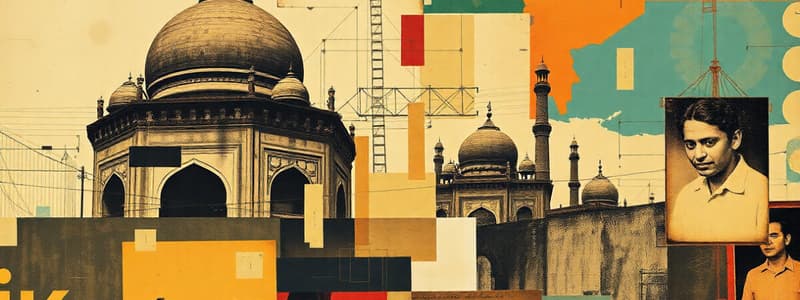Podcast
Questions and Answers
Which historical factor most directly contributed to the emergence of Hindustani as a language of common communication?
Which historical factor most directly contributed to the emergence of Hindustani as a language of common communication?
- The standardization efforts of British administrators in the 18th century.
- Bharatendu Harishchandra's role in modernizing Hindi literature in the late 19th century.
- The establishment of a committee to standardize Hindi terminology in 1954.
- The influence of Persian during the Delhi Sultanate and Mughal Empire. (correct)
How does the constitutional status of Hindi in India impact language policy and promotion?
How does the constitutional status of Hindi in India impact language policy and promotion?
- It designates Hindi as an official language of the Union Government and directs its promotion, alongside English. (correct)
- It imposes Hindi as the sole language of instruction in all educational institutions nationwide, neglecting multilingual education policies.
- It requires all states to adopt Hindi as their primary official language, overriding local linguistic preferences.
- It mandates the exclusive use of Hindi in all government communications, limiting regional language usage.
What linguistic feature differentiates the Devanagari script from a purely alphabetic writing system?
What linguistic feature differentiates the Devanagari script from a purely alphabetic writing system?
- Devanagari is written from right to left, unlike alphabetic systems that are written from left to right.
- Devanagari uses distinct symbols for each vowel and consonant, similar to alphabetic systems.
- Devanagari is an abugida script where consonants have an inherent vowel that can be modified or suppressed. (correct)
- Devanagari only represents consonants, while vowels are inferred by the reader based on context.
Which of the following represents the correct chronological sequence of Hindi's evolution?
Which of the following represents the correct chronological sequence of Hindi's evolution?
Considering the geographical distribution of Hindi, what factor explains the presence of Hindi speakers in cities outside the Hindi Belt?
Considering the geographical distribution of Hindi, what factor explains the presence of Hindi speakers in cities outside the Hindi Belt?
What distinguishes Modern Standard Hindi from Hindustani?
What distinguishes Modern Standard Hindi from Hindustani?
Why is the promotion and development of Hindi by the Union Government of India a subject of linguistic and political debate?
Why is the promotion and development of Hindi by the Union Government of India a subject of linguistic and political debate?
How would you describe the relationship between Prakrit languages and Sanskrit in the context of Hindi's historical development?
How would you describe the relationship between Prakrit languages and Sanskrit in the context of Hindi's historical development?
Which of the following statements accurately describes the impact of loanwords on Hindi vocabulary?
Which of the following statements accurately describes the impact of loanwords on Hindi vocabulary?
How does the split ergative system in Hindi grammar affect sentence construction and meaning?
How does the split ergative system in Hindi grammar affect sentence construction and meaning?
How do the standardized forms of Hindi and Urdu diverge, and what is the role of Hindustani in bridging this divergence?
How do the standardized forms of Hindi and Urdu diverge, and what is the role of Hindustani in bridging this divergence?
What implications arise from Hindi being a syllable-timed language, particularly in contrast to stress-timed languages?
What implications arise from Hindi being a syllable-timed language, particularly in contrast to stress-timed languages?
In what ways did the Bhakti movement influence the development and characteristics of early Hindi literature?
In what ways did the Bhakti movement influence the development and characteristics of early Hindi literature?
How does the predictability of stress in Hindi influence the language's prosody and rhythm?
How does the predictability of stress in Hindi influence the language's prosody and rhythm?
What is the significance of compound verbs in Hindi, consisting of a main verb and an auxiliary verb, and how do they function grammatically?
What is the significance of compound verbs in Hindi, consisting of a main verb and an auxiliary verb, and how do they function grammatically?
What are the primary challenges Hindi faces despite being one of the most widely spoken languages, and how do these affect its future development?
What are the primary challenges Hindi faces despite being one of the most widely spoken languages, and how do these affect its future development?
How does nasalization, as a distinctive feature in Hindi vowels, alter the meaning of words, and what implications does this have for pronunciation and comprehension?
How does nasalization, as a distinctive feature in Hindi vowels, alter the meaning of words, and what implications does this have for pronunciation and comprehension?
How do gender and number inflections on Hindi nouns interact with adjective agreement, and what challenges do these features pose for language learners?
How do gender and number inflections on Hindi nouns interact with adjective agreement, and what challenges do these features pose for language learners?
Flashcards
What is Hindi?
What is Hindi?
An Indo-Aryan language primarily spoken in India.
Origin of Hindi
Origin of Hindi
Evolved from Middle Indo-Aryan dialects (Prakrits) and can be traced back to the 7th century AD.
What is Hindustani?
What is Hindustani?
A language of common communication that emerged during the Delhi Sultanate and Mughal Empire due to Persian influence on Hindi.
What is the Hindi Belt?
What is the Hindi Belt?
Signup and view all the flashcards
Official Language Status in India
Official Language Status in India
Signup and view all the flashcards
Hindi Characters
Hindi Characters
Signup and view all the flashcards
What is Devanagari?
What is Devanagari?
Signup and view all the flashcards
Devanagari: Abugida Script
Devanagari: Abugida Script
Signup and view all the flashcards
Aspirated Consonants
Aspirated Consonants
Signup and view all the flashcards
Retroflex Consonants
Retroflex Consonants
Signup and view all the flashcards
Nasalized Vowels
Nasalized Vowels
Signup and view all the flashcards
Syllable-Timed Language
Syllable-Timed Language
Signup and view all the flashcards
SOV Language
SOV Language
Signup and view all the flashcards
Postpositions
Postpositions
Signup and view all the flashcards
Split Ergative System
Split Ergative System
Signup and view all the flashcards
Compound Verb
Compound Verb
Signup and view all the flashcards
Loanwords
Loanwords
Signup and view all the flashcards
Hindustani
Hindustani
Signup and view all the flashcards
Study Notes
- Hindi is an Indo-Aryan language spoken chiefly in India
- Modern Standard Hindi is one of the two official languages of the Government of India
- It is an official language in 9 states and 3 union territories
History
- Hindi's origin can be traced back to the 7th century AD
- It evolved from the Middle Indo-Aryan dialects called Prakrits
- These Prakrits further evolved from Sanskrit
- By the 13th century, Apabhramsa, a descendant of Prakrit, was taking a recognizable form
- This form is considered an early version of Hindi
- During the Delhi Sultanate (1206–1526) and Mughal Empire (1526–1806), Persian influenced Hindi
- Hindustani emerged as a language of common communication
- In the 18th century, a standardized form of Hindi began to develop
- This form was promoted by British administrators and Indian intellectuals
- Bharatendu Harishchandra played a vital role in modernizing Hindi literature in the late 19th century
- In 1954, the Indian government established a committee to standardize Hindi terminology
Geographical Distribution
- Hindi is primarily spoken in the Hindi Belt region of India
- This region includes states like Uttar Pradesh, Madhya Pradesh, Bihar, and Rajasthan
- Significant Hindi-speaking populations also exist in other parts of India, such as Delhi, Haryana, and Himachal Pradesh
- Due to migration, Hindi speakers are present in major cities throughout India
- Outside India, Hindi is spoken by diaspora communities in countries like Nepal, Fiji, Mauritius, and South Africa
Official Status
- Hindi, along with English, is one of the official languages of the Union Government of India
- Article 343 of the Indian Constitution designates Hindi as the official language
- The Constitution directs the Union Government to promote the spread and development of Hindi
- Hindi is also the official language of several states in India
- These states include Uttar Pradesh, Bihar, Jharkhand, Uttarakhand, Madhya Pradesh, Haryana, Rajasthan, Chhattisgarh, and Himachal Pradesh
- Hindi is also an official language in the union territories of Delhi, Andaman and Nicobar Islands, and Jammu and Kashmir
Writing System
- Hindi is written in the Devanagari script
- Devanagari is an abugida script
- In Devanagari, each consonant has an inherent vowel that can be modified or suppressed
- The script is written from left to right
- It consists of 11 vowels and 33 consonants
- Devanagari is also used to write other languages like Sanskrit, Marathi, and Nepali
Phonology
- Hindi has a relatively large phoneme inventory
- It includes both aspirated and unaspirated consonants
- Hindi also features retroflex consonants
- The vowel system of Hindi includes both short and long vowels
- Nasalization is a distinctive feature in Hindi vowels meaning nasal vowels can change the meaning of a word
- Hindi is a syllable-timed language
- Stress is generally predictable and falls on the penultimate syllable
Grammar
- Hindi is an SOV (subject-object-verb) language
- Grammatical relations are primarily indicated by postpositions
- Hindi has a split ergative system
- Nouns in Hindi are inflected for gender (masculine and feminine) and number (singular and plural)
- Verbs in Hindi agree with the subject in gender and number
- Hindi verbs are also inflected for tense, aspect, and mood
- The language makes extensive use of compound verbs
- These compound verbs consist of a main verb followed by an auxiliary verb
- Adjectives in Hindi generally precede the nouns they modify
- They agree with the noun in gender, number, and case
Vocabulary
- The vocabulary of Hindi is derived from Sanskrit, Prakrit, Persian, Arabic, and English
- Many basic vocabulary items come from Sanskrit and Prakrit
- Persian and Arabic have contributed a significant number of loanwords
- The influence of English is evident in modern Hindi vocabulary
- Government efforts have focused on creating Hindi equivalents for English terms
- This is intended to promote the use of Hindi in official and technical contexts
Literature
- Hindi literature has a rich history
- Early Hindi literature includes religious and devotional poetry
- The Bhakti movement in medieval India produced numerous Hindi poets
- Prominent Bhakti poets include Tulsidas, Surdas, and Mirabai
- Modern Hindi literature emerged in the late 19th century
- Key figures in modern Hindi literature include Bharatendu Harishchandra, Munshi Premchand, and Jaishankar Prasad
- Contemporary Hindi literature includes novels, short stories, poetry, and drama
Influence and Relationship with Urdu
- Hindi and Urdu are closely related languages
- They share a common origin in the Hindustani language
- The main difference between Hindi and Urdu lies in their standardized forms
- Hindi draws vocabulary heavily from Sanskrit
- Urdu draws vocabulary from Persian and Arabic
- In colloquial speech, Hindi and Urdu are often mutually intelligible
- The divergence between the two languages is more pronounced in formal and literary registers
- Hindustani serves as a bridge between Hindi and Urdu
- It is a spoken language that incorporates elements of both
Status and Future
- Hindi is one of the most widely spoken languages in the world
- The Indian government is actively promoting the use of Hindi through various initiatives
- These initiatives include the creation of educational materials and the standardization of terminology
- Hindi cinema, also known as Bollywood, has played a significant role in popularizing the language
- The increasing use of the internet and social media has also contributed to the spread of Hindi
- Despite its widespread usage, Hindi faces challenges
- These challenges include regional resistance and the dominance of English in certain sectors
- The future of Hindi depends on continued efforts to promote its use and development
Studying That Suits You
Use AI to generate personalized quizzes and flashcards to suit your learning preferences.




